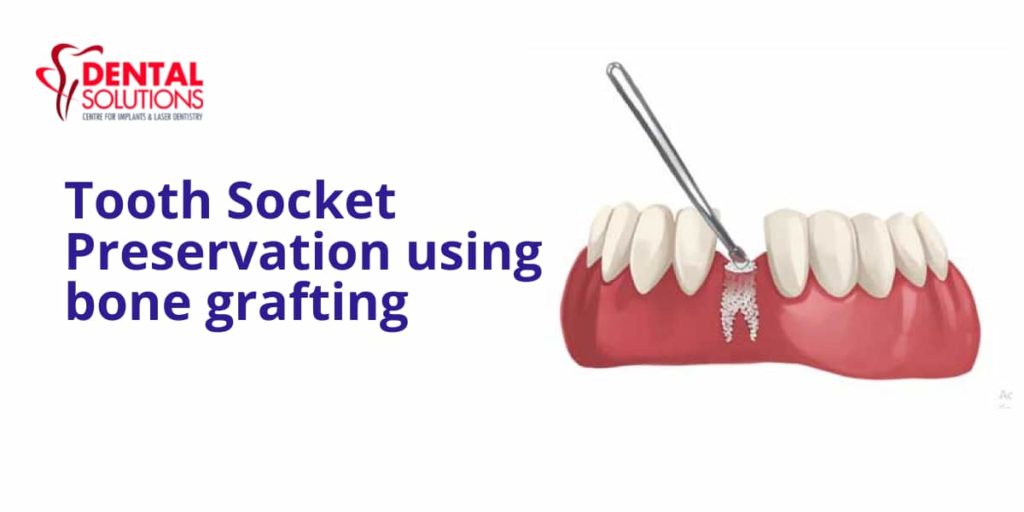- +917892951808
- Indiranagar, Bangalore
Best Dental Clinic In Bangalore Indiranagar | Best Dentist in Bangalore Indiranagar
- Home
- About Us
- Treatments
- Blog
- Contact Us

The way our bodies work is phenomenal. Take, for instance, our jawbones. When a tooth is extracted, the jawbones start reshaping – the bone surrounding the roots of the teeth (alveolar ridge) begin to dissolve and wash away, or rather disappear. This happens because the body recognizes that the tooth has gone away and hence to conserve material and blood supply it starts with demolishing the tissues surrounding the tooth. But! But! But!
Preserving the socket after bone removal is extremely important. This article highlights why preserving a bone socket is important, What Happens During tooth Socket Preservation? And what can happen if tooth socket preservation is not done in time?
Once a permanent tooth is lost, it's lost forever. This is mostly in cases of a wisdom tooth removal or an abscessed tooth that could not be saved. While dentists will do everything possible, using alternative treatments to save the tooth, however, tooth extraction isn't always avoidable and a tooth has to be extracted if it cannot be saved.
After the tooth has been extracted, a hole, called a socket, will be visible or present. This hollow in the gum exactly tells where the tooth was, each tooth in the mouth has its own space. Now, with absolutely no tooth covering the socket, nerve endings and part of the jaw bone become exposed. The body's natural response to tooth extraction is to create a blood clot over the now vacant socket. The blood clot initiates the healing process of the gum, bone and other tissue of the affected area. The clot also provides a protective barrier of the now exposed nerve endings. The bone surrounding the tooth now starts disappearing.
What is tooth socket preservation?
It is very important to preserve the bone socket, hence after tooth extraction, dentists use a technique called tooth socket preservation using bone grafting to counteract the body's natural occurrence of bone erosion and preserve its structural integrity and keep the area strong. . This type of graft is used to fill an extraction socket with material that can heal into solid bone. For best results, a socket preservation bone graft must be placed at the time of tooth extraction
Why is Tooth Socket Prevention Important?
As we know, each tooth is securely attached to the jaw bone with an intricate network of bone, nerves, soft tissue, and ligaments. When an extraction takes place oral health can be severely affected if the socket is not preserved.
Some of the benefits of tooth socket preservation include:
- It prevents teeth from drifting out of place.
- It helps to prevent dry sockets. Dry Socket is a painful condition wherein the blood clot that should form after removal is dislodged or dissolved before the wound heals, exposing underlying bone and nerves.
- Helps prevent the surrounding teeth from gradually moving into the empty space and, causing crooked teeth and or a misaligned bite.
- Tooth Socket preservation can correct or amend any deformity that may exist in the alveolar ridge or socket
- Further, it also has advantages for people proceeding with dentures, implants or dental bridges. It also has benefits for patients who choose not to replace their lost tooth. Bone loss and gum recession at the extraction site can expose tooth roots on neighbouring teeth. These exposed areas can be very temperature-sensitive. Additionally, a tooth socket preservation graft will preserve more bone at the extraction site to support adjacent teeth.
What happens during tooth socket preservation?
Before we understand the procedure, you must know that the alveolar ridge can't be replaced without surgical intervention, hence bone grafting is a surgical procedure. While socket preservation can be done using synthetic materials or artificial materials, most dentists prefer using the patient's own bone – own bone from the hip or back of the jaw is used, which is known as an autograft. This type of dental graft promotes faster healing and bone formation. At times a matching donor's bone can be used for the procedure.
Types of dental bone grafts for tooth socket preservation include
- Autografts – Involves bone from your own body, such as from your hip or jaw.
- Allografts – Uses bone from a different person
- Xenografts – Use of bone from another species, mostly animals
- Alloplastic – Use of synthetic material in bone graftings, such as calcium phosphate or Bioglass.
There are several ways dental bone grafting can be done, but the basic procedure is the same: A dentist or oral surgeon makes an incision in the jaw and grafts (attaches) other bone material to the jaw.
Here's how the typical dental bone graft is done:
- Before the procedure, you will need to undergo a test to have all your vitals checked. Right before the procedure starts, you will receive anaesthesia. Once done, the affected area will be cleaned.
- An incision will be made in the gum to separate it from the bone where the graft is to be placed. The surgeon will place the bone material between two sections of bone that need to grow together.
- After the bone graft is placed it is secured with a special collagen material, more like a dissolvable adhesive or with special screws.
- The incision is then stitched for it to begin healing.
What are the types of bone graft procedures?
There are three main types of dental bone grafts procedures. Each one is useful for different circumstances affecting the jaw.
1. Block bone graft
Bone is typically taken from the back of the jawbone – This is usually done in cases where there's been significant bone loss toward the front of the jaw.
2. Sinus lift
A sinus bone graft is done to preserve or restore upper jaw stability when bone loss has occurred near the upper molars.
3. Socket graft
A bone graft that is done at the same time a tooth is extracted in order to avoid bone loss that might otherwise occur once the tooth is extracted.
1. Block bone graft
Bone is typically taken from the back of the jawbone – This is usually done in cases where there's been significant bone loss toward the front of the jaw.
2. Sinus lift
A sinus bone graft is done to preserve or restore upper jaw stability when bone loss has occurred near the upper molars.
3. Socket graft
A bone graft that is done at the same time a tooth is extracted in order to avoid bone loss that might otherwise occur once the tooth is extracted.
Do I need tooth socket preservation?
Dental implants are the most common way to preserve these sockets. If you skip having an implant after tooth extraction or any restoration procedure, the surrounding tissues will be affected and the bone surrounding will begin to deteriorate. Also, your teeth will start shifting which can cause them to move in any direction. You will then start having gaps in your teeth or existing gaps may turn larger. Not preserving the socket along with proper restoration treatment, can also result in other oral health issues like inability to bite and chew food properly, increased risk of cavities or gum disease.
Are you having one or more teeth extracted? Be sure to ask your dentist about socket preservation.
